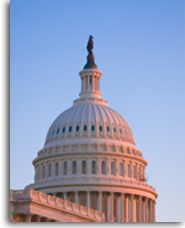This weekend the DLC National Conversation (our annual meeting) got under way in Columbus, Ohio. Today’s public session, featuring speeches by Hillary Clinton, Tom Vilsack (our new chairman), Evan Bayh, Mark Warner, and Tom Carper, will undoubtedly get some serious national press, but in some respects, the heart of the meeting was yesterday, when we held 22 workshops on a variety of policy and political topics. We knew there would be more than 300 state and local elected officials here from more than forty states, but the interesting thing was that every one of them seemed to show up for a full menu of three workshops. I moderated three of them. The first, on “values and frames” (a discussion of the Lackoffian theory of message development, and others, including our own) had to be moved to an auditorium after about 80 people showed up. The second, on Religion and Politics, was SRO. And even in the shank of the afternoon, we had a full room for a discussion of that wonkiest of political topics, election reform and redistricting reform. And best as I could tell, every other workshop was pretty much sold-out as well. These folks (about half of whom were attending their first DLC national event) are hungry to learn and win.Those folks who think of the DLC as an inside-the-beltway organization of old white guys would probably have been surprised by the sheer number of state and local attendees, and their diversity in terms of race and gender (about half the attendees were women). Even ideologically, I think we drew a fairly representative cross-section of state and local Democratic elected officials. The tone of most sessions, though infused with a sense of urgency, was upbeat. There was no talk of litmus tests or purges (please take note, Kos), and as usual with these events, a lot of networking and best-practices exchanges in small gatherings between the formal meetings. We were picketed by a local activist group called the Spine Project which pretty much shows up at every Democratic gathering in Ohio to express their displeasure at the Party’s failure to challenge the presidential outcome in this state. But it was reasonably friendly. All in all, the vibes have been good, and I expect that to continue today.
TDS Strategy Memos
Latest Research from:

Editor’s Corner
By Ed Kilgore
-
March 6: Trump Job Approval Again Underwater, Where It Belongs
As an inveterate poll-watcher, I have been waiting for the moment when Donald Trump’s job approval numbers went underwater, his accustomed position for nearly all of his presidential career. It arrived around the time he made his speech to Congress, as I noted at New York:
Even as he was delivering the most partisan address to Congress maybe ever, Donald Trump’s public support seemed to be regularly eroding. An updated FiveThirtyEight average of Trump’s approval ratings on March 4 (released just as news broke that ABC was shutting down the revered data site) showed him going underwater for the first time since reoccupying the White House, with 47.6 percent approval and 47.9 percent disapproval. That puts Trump back in the same territory of public opinion he occupied during his first term as president, where (per Gallup) he never achieved more than 50 percent job approval, and averaged a mere 41 percent.
Perhaps Trump will get lucky and conditions in the country will improve enough to validate his agenda, but it’s more likely that the same sour public climate that overwhelmed Joe Biden will now afflict his predecessor and successor.
The Reuters/Ipsos survey that pushed Trump’s numbers into negative territory showed a mood very different from the 47th president’s boasts about a new “golden age” for our country:
“Thirty-four percent of Americans say that the country is headed in the right direction, compared to 49% who say it is off on the wrong track. When it comes to several specific issues, Americans are more likely to say things are off on the wrong track than going in the right direction: cost of living (22% right direction / 60% wrong track), the national economy (31% right direction / 51% wrong track), national politics (33% right direction / 50% wrong track), American foreign policy (33% right direction / 49% wrong track), and employment and jobs (33% right direction / 47% wrong track).”
So all the hype about Trump being a popular president who was in the midst of engineering a major realignment of the American electorate is already looking more than a bit hollow. Trump has a solid Republican base of support and a solid Democratic opposition, with independents currently leaning towards the Democratic Party on most issues. Perhaps Trump’s agenda will gain momentum and support, but since he’s not trying to reach out beyond his party’s base at all, he’s going to need a lift from Americans who only voted for him in 2024 as the lesser of evils and may not vote in the 2026 midterms at all.
At present Trump has lost whatever presidential “honeymoon” he initially enjoyed after his return to the White House, and needs to find new converts to return to genuine popularity. He’s not off to a great start.


